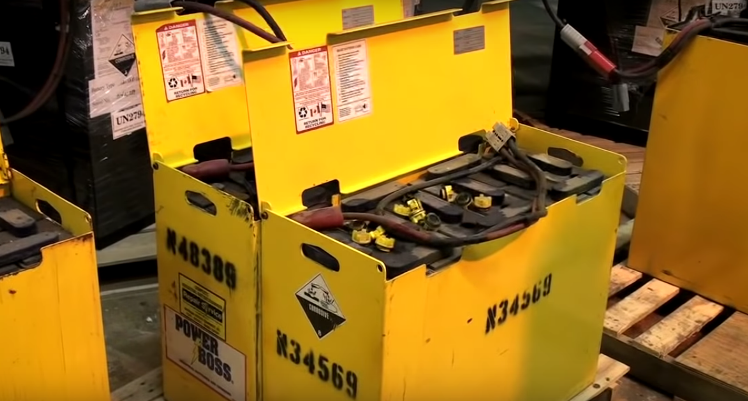Simple Guide to Forklift Battery Maintenance
In this post, we'll outline the basic steps to forklift battery maintenance.
We have over 40 years in the material handling industry, and we would love to share our expertise and experience with you.
This comprehensive guide will outline what you need to do and when to keep your forklift battery in great shape so that it lasts as long as possible. So, let's get going.
Forklift Battery Maintenance
Proper forklift battery maintenance will help it last longer -Image Source: NationalLiftTruck
Proper forklift battery maintenance will not only prolong the life of your battery, thus saving you on replacement costs, but it will also ensure the safety of your workers.
As part of your forklift batter maintenance plan, you should regularly:
Perform equalization charges
Water your battery cells
Wash your battery case
By setting up a regular forklift battery maintenance schedule at set intervals, you can possibly extend the life of your lead acid battery as long as possible; even past the warranty dates.
Step 1: Perform Equalization Charges
As your battery gets used, the cells can lose their capacity to fully hold a charge. For example, one of your cells in your battery may be fully charged while another one is only able to hold half of a charge. If this happens, then your battery becomes less efficient.
An equalization charge will help prolong the life of your forklift battery - Image Source: NationalLiftTruck
Performing an equalization charge can fix this problem. A regular forklift battery recharge cycle lasts about 8 hours. When you do an equalization charge, you continue charging your battery for an extra 3 hours or more at a lower stream of power.
This additional lower charging should make all your cells hold a full charge once again. Because this type of charging can take longer, you will also need to let your battery cool down longer.
It is a good idea to perform equalization charges on the weekend or when production is slower so that you can fit in the extra charging and cooling time necessary.
Frequency: Once a week depending on how often it is used
Step 2: Water Your Battery Cells
You need to make sure that you maintain the correct water level inside your battery. Your water level should come to about a half an inch below the battery cap opening.
The electrolyte level needs to be kept between the "high watering level" and the separator protectors marked on your battery.
Pour water carefully into the filler wells
Image Source: National Institute of Standards and Technology [Public domain]
Make sure that you don't overfill your battery. If you notice moisture on the tops of your batteries, then you will know that it has been overfilled.
An important part of proper forklift battery maintenance is watering your battery
You should only add water to your battery after you have performed a charge cycle. The type of water that you add is very important; it should only be distilled and deionized water. Make sure you check your owner's manual for the specifications.
Frequency: Weekly or bi-monthly depending on how often it is used
Step 3: Wash Your Battery Case
Keeping your battery case clean will help to prolong its life. If battery acid residue builds up on your battery, you could have a couple of problems.
First, It can make a conductive circuit between the lead posts and its steel case, causing a low-level discharge. This will make your battery burn through its charge cycles and wear out faster.
Clean your battery case of any residue to prevent corrosion -Image Source: NationalLiftTruck
Second, it can corrode the terminals and damage them. This damage could cause electrical problems with your forklift itself and it can lessen your battery capacity.
To clean your battery case, you should spot clean the tops using an acid-neutralizing de-greaser. Make sure the vent caps are sealed tightly before you begin. If your cleaning solution seeps into the electrolyte (battery acid), then your battery will be ruined.
Frequency: Every month depending on how often it is used
In addition, you should thoroughly wash your entire battery to help control acid and corrosion.
Frequency: Every 3 to 6 months depending on how often it is used
Additional Forklift Battery Maintenance Tips
Forklift batteries contain a dangerous corrosive material called sulfuric acid that can cause severe burns. Because of this, your staff should always wear protective gear when handling and charging them.
Keep flames and metal away from battery tops. For this reason, you should remove any metal jewellery when you are handling a forklift battery.
For Proper Forklift Battery Maintenance, Contact Forklift Hub.
If you are looking for assistance in caring for your forklift batteries, Wayco offers a comprehensive battery care program.
We will provide monthly, quarterly, semi-annual or yearly inspection of your equipment, batteries, and chargers, making sure they are maintained correctly and on a routine basis.
Contact Forklift Hub today to schedule your service.
Best Forklift Warranties in the Business
Whether you are in the market for a new or used forklift, talk to the professionals at Wayco. Wayco offers the best warranties in the business for both new and used forklifts so you can purchase with confidence!







